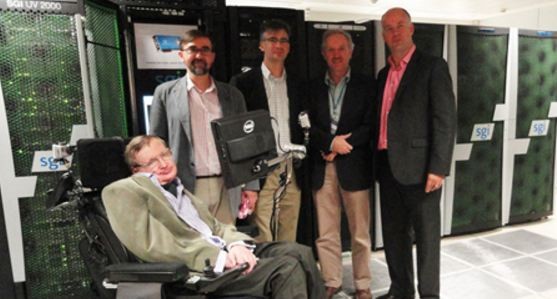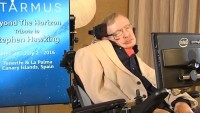Stephen Hawking and COSMOS to Map the Known Universe in 3D
| Arthur Dominic Villasanta | | Jul 03, 2016 05:51 AM EDT |
(Photo : Cambridge University) Stephen Hawking and the COSMOS MK IX supercomputer at Cambridge University
World renowned theoretical physicist Stephen Hawking has announced a truly ambitious project to map the known Universe in 3D using the COSMOS supercomputing facility at Cambridge University in the United Kingdom.
COSMOS was founded in January 1997 by a consortium of leading UK cosmologists brought together by Hawking. The project will plot the position of billions of cosmic structures including galaxies, black holes and supernovas to create the most detailed 3D map of the early Universe to date, said Hawking.
Like Us on Facebook
The COSMOS supercomputer, COSMOS Mk IX, is an Altix UV2000 system from SGI. COSMOS Mk IX is the largest shared-memory computer in Europe and is being used to support research in cosmology, astrophysics and particle physics.
COSMOS Mk IX features 1856 Intel Xeon E5 processor cores (SandyBridge-EP) with 14.5TB of globally shared memory. It was boosted further in December 2012 with 31 Intel Many Integrated Core (MIC) co-processors, providing a hybrid hierarchical SMP/MIC computing platform.
COSMOS Mk IX will create the 3D map relying on data from two previous surveys: the Planck satellite from the European Space Agency and the Dark Energy Survey, an optical/near-infrared survey probing the dynamics of the expansion of the Universe over the last 10 billion years and the growth of large scale structures.
The COSMOS team will use Planck satellite to form detailed images of the Cosmic Microwave Background (CMB), or the radiation leftover by the Big Bang. These images of the oldest light in the cosmos allowed physicists to refine their estimates for the age of the Universe to 13.82 billion years, and its rate of expansion.
This information will be combined with data from the Dark Energy Survey. From all of this, the COSMOS team will compare the early distribution of matter in the Universe with its subsequent expansion to see how the two combine. This will be the first time scientists compare data the early Universe to its evolution since the Big Bang.
TagsStephen Hawking, COSMOS supercomputing facility, Cambridge University, Altix UV2000 system
©2015 Chinatopix All rights reserved. Do not reproduce without permission
EDITOR'S PICKS
-

Did the Trump administration just announce plans for a trade war with ‘hostile’ China and Russia?
-

US Senate passes Taiwan travel bill slammed by China
-

As Yan Sihong’s family grieves, here are other Chinese students who went missing abroad. Some have never been found
-

Beijing blasts Western critics who ‘smear China’ with the term sharp power
-

China Envoy Seeks to Defuse Tensions With U.S. as a Trade War Brews
-

Singapore's Deputy PM Provides Bitcoin Vote of Confidence Amid China's Blanket Bans
-

China warns investors over risks in overseas virtual currency trading
-

Chinese government most trustworthy: survey
-

Kashima Antlers On Course For Back-To-Back Titles
MOST POPULAR
LATEST NEWS
Zhou Yongkang: China's Former Security Chief Sentenced to Life in Prison

China's former Chief of the Ministry of Public Security, Zhou Yongkang, has been given a life sentence after he was found guilty of abusing his office, bribery and deliberately ... Full Article
TRENDING STORY

China Pork Prices Expected to Stabilize As The Supplies Recover

Elephone P9000 Smartphone is now on Sale on Amazon India

There's a Big Chance Cliffhangers Won't Still Be Resolved When Grey's Anatomy Season 13 Returns

Supreme Court Ruled on Samsung vs Apple Dispute for Patent Infringement

Microsoft Surface Pro 5 Rumors and Release Date: What is the Latest?













